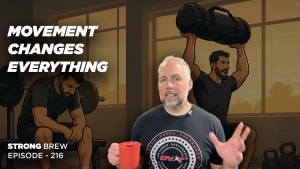
The System That Saved My Coaching Career: A Tribute to DVRT
I was this close to leaving the fitness industry. After years of “doing everything right” the way I’d been taught in school—body-part splits, machines, chasing bigger numbers—I hit a wall of boredom and frustration. Something in me knew: if this was all there was to strength training, I was out.
So I did what a lot of us do when we’re desperate for answers: I went down the rabbit holes. I started asking better questions about movement, about how real people actually live in their bodies, and about why there was such a huge gap between what I learned in textbooks and what I was seeing on the gym floor.
Eventually, those rabbit holes led me somewhere that changed everything: DVRT — Dynamic Variable Resistance Training.
From Textbook Knowledge to Real-World Movement
In “fitness school,” I learned about planes of motion, muscle groups, and joint actions. But I didn’t learn how to connect those concepts to real-life movement in a way that made sense for everyday people—parents, desk workers, caregivers, adults dealing with stress, anxiety, and the wear and tear of life. :contentReference
DVRT became the bridge between theory and practice. It showed me how:
- Changing the plane of motion can instantly change the intensity and purpose of an exercise.
- Altering holding positions—like front-loaded, shoulder, or fist positions with the Ultimate Sandbag—can dramatically shift how the body has to stabilize and connect. :contentReference
- Using different body positions (tall kneeling, half kneeling, staggered stance, single-leg, marching, and more) turns “just another rep” into a powerful stability and coordination challenge.
Once you start combining planes of motion, holding positions, and body positions, the training possibilities explode. And that’s exactly what pulled me back from burnout—suddenly, strength training was no longer a grind; it was an endlessly rich system for helping people move better.
When the Implement Becomes Feedback, Not Just Resistance
One of the most powerful shifts DVRT gave me was how I saw equipment. The Ultimate Sandbag, kettlebells, lever bells, and resistance bands stopped being just “weight” and started becoming teaching tools.
When I pulled the Ultimate Sandbag in close and created tension through my hands, core, and feet, my body finally understood what “connected strength” felt like. My low-back pain—something I’d just accepted as part of heavy training—began to disappear almost overnight.
Squats stopped hurting. Deadlifts stopped scaring me. Higher-level movements actually made me feel more mobile and resilient. And I knew if this system could help me like that, it could absolutely help the people I was called to serve.
Why DVRT Became the Backbone of Fitness Lying Down
Fitness Lying Down was born out of that vision: to bring this kind of intelligent, movement-based strength training to the general population—people who sit at desks, raise kids, care for aging parents, work from home, and carry the weight of real life on their shoulders.
Instead of locking people into machines that dictate how their body has to move, DVRT allows the body to move more freely, with tools that move with them, not against them. Ultimate Sandbags, kettlebells, lever bells, and bands take up less space, cost less than big machines, and are endlessly versatile for building strength, stability, and confidence.
As a gym owner, that’s powerful. As a coach, it’s priceless. And as a community, we’ve seen the results firsthand: better retention, more engagement, and clients who are genuinely excited to keep learning and moving because no two sessions feel exactly the same.
Why Our Clients Love This “Different” Kind of Strength Training
Our clients notice quickly that what we do at Fitness Lying Down doesn’t feel like “fitness as usual.” We’re not just cranking out reps on machines or repeating the same barbell lifts without context. We’re:
- Teaching their bodies how to navigate gravity under load.
- Building stability from the ground up—hands, feet, and everything in between.
- Layering progressions so they’re always challenged, but never crushed.
- Helping them move better outside the gym: lifting groceries, shoveling snow, playing with kids or grandkids, and living life with more ease.
Every small tweak—changing stance, shifting the bag, rotating through a new plane of motion—keeps them learning, not just sweating. And that’s where the real transformation happens.
A Grateful Shout-Out to DVRT HQ
None of this would exist without the work of Josh Henkin and Jessica Bento at DVRT Headquarters. Their humility, intelligence, and commitment to building a complete, inclusive training system quite literally changed the trajectory of my career—and I truly believe, the lives of the people we serve at Fitness Lying Down.
If it wasn’t for DVRT, I’m not sure there would even be a Fitness Lying Down. For that, I’m incredibly grateful.
It turned “just working out” into purposeful movement. It turned isolated muscles into an integrated system. And it continues to shape every session, every program, and every client experience at Fitness Lying Down.
Ready to experience what intentional, movement-based strength training feels like?
Come try DVRT with us at Fitness Lying Down and feel the difference for yourself.
Your body doesn’t just need more weight. It needs better movement.
Watch the Full Strong Brew Episode
In this conversation, I share the full story of how DVRT transformed my coaching and why we continue to use it 100% at Fitness Lying Down.
